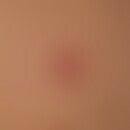Synonym(s)
DefinitionThis section has been translated automatically.
Genetically heterogeneous hereditary hyperinflammatory syndrome associated with the histiocytoses (see also under"Hemophagocytic lymphohistiocytosis secondary"), caused by a massively exuberant, sepsis-like, inflammatory reaction of the immune system with overwhelming activation of T lymphocytes and macrophages. The disease is life-threatening.
The clinical picture often differs little from sepsis, SIRS, or severe infection and is protracted. Often occurring in combination with primary immunodeficiency diseases (see below Immunodeficiencies primary (overview and classification).
Occurrence/EpidemiologyThis section has been translated automatically.
The incidence of hereditary HLH in Sweden has been estimated at 0.12/100,000 children <15 years, corresponding to 1/50,000 live births.
HLH in newborns and infants is usually based on the congenital form.
You might also be interested in
EtiopathogenesisThis section has been translated automatically.
In genetically heterogeneous, hereditary HLH, mutations are found in several genes important for theprovision and function of cytotoxic granules:
- Type 1: AR/ defects of the hemophagocytic lymphohistiocytosis 1 gene(HPLH1 gene; gene locus: 9q21.3-q22).
- Type 2: AR/ defects of hemophagocytic lymphohistiocytosis 2 gene(PRF1 gene; perforin 1 gene; gene locus: 10q22) with consecutive defects of perforin.
- Type3: AR/ defects in the UNC13D gene (UNC13D stands for "Unc-13 Homolog D"). The encoded protein, belongs to the UNC13 family and has a similar domain structure to other family members. However, the molecule lacks an N-terminal phorbol ester-binding C1 domain, which is present in other Munc13 proteins.
- Type 4 (603552), caused by a mutation in the syntaxin 11 gene(STX11; 605014) on chromosome 6q24.
- Type 5 (613101), caused by a mutation in syntaxin-binding protein-2(STXBP2; 601717), which is an interacting partner of syntaxin 11 (see STX11 below), on chromosome 19p13.
ManifestationThis section has been translated automatically.
ClinicThis section has been translated automatically.
The triad of symptoms is characteristic:
- prolonged fever
- hepatosplenomegaly
- B- or pancytopenia
Other possible signs of the disease are neurological symptoms, lymphadenopathy, hepatitis, coagulation disorders, pulmonary infiltrates, pleural effusion and ascites, diarrhea, etc.
Persistent lymph node swelling and jaundice are rarer.
In childhood, neurological symptoms such as seizures, meningitic signs or cranial nerve deficits are observed in about 1/3 of patients.
Dermatologically, petechiae, eczematous skin changes and recurrent purulent bacterial infections (abscesses) are frequently found; furthermore, viral secondary infections with herpes viruses(herpes simplex, varicella zoster virus, EBV). See also Hemophagocytic lymphohistiocytosis (secondary)
LaboratoryThis section has been translated automatically.
DiagnosisThis section has been translated automatically.
Differential diagnosisThis section has been translated automatically.
TherapyThis section has been translated automatically.
Chemoimmunotherapy in the acute stage, followed by allogeneic hematopoietic stem cell transplantation. As a rule, etoposide-containing therapies. In case of recurrence or resistance to therapy, a treatment regimen with anti-interferon-gamma antibody (emapalumab) has been approved by the FDA.
.
Progression/forecastThis section has been translated automatically.
Extremely unfavorable without allogeneic bone marrow transplantation. Good prognosis after allogeneic bone marrow transplantation (rare recurrences).
LiteratureThis section has been translated automatically.
- Dufourcq-Lagelouse R et al. (1999) Linkage of familial hemophagocytic lymphohistiocytosis to 10q21-22 and evidence for heterogeneity. Am J Hum Genet 64: 172-179
- Farquhar JW, Claireaux AE (1952) Familial haemophagocytic reticulosis. Arch Dis Child 27: 519-525
- Farquhar JW, MacGregor AR, Richmond J (1958) Familial haemophagocytic reticulosis. Brit Med J 2: 1561-1564
- Imashuku S et al. (2004) Longitudinal follow-up of patients with Epstein-Barr virus-associated hemophagocytic lymphohistiocytosis. Haematologica 89: 183-188
- Ioannidou D (2003) Langerhans' cell histiocytosis and haemophagocytic lymphohistiocytosis in an elderly patient. J Eur Acad Dermatol Venereol 17: 702-705
- Ohadi M et al. (1999) Localization of a gene for familial hemophagocytic lymphohistiocytosis at chromosome 9q21.3-22 by homozygosity mapping. Am J Hum Genet 64: 165-171
Zhang K et al. (2006) Familial Hemophagocytic Lymphohistiocytosis. In: Adam MP, Feldman J, Mirzaa GM, et al, editors. GeneReviews® [Internet]. Seattle (WA): University of Washington, Seattle; 1993-2024. available from: https://www.ncbi.nlm.nih.gov/books/NBK1444/
Incoming links (16)
Abt-letterer-siwe disease; Epstein-Barr-Virus and recurrent infections; Griscelli syndrome; Hemophagocytic lymphohistiocytosis; HHV-8; HPLH1 Gene; Immunodeficiency 45; Lymphohistiocytosis, familial erythrophagocytosis; Lymphoproliferative syndrome type 2 ; Lymphoproliferative syndrome X-linked, type 2; ... Show allOutgoing links (14)
Fda; Herpes simplex virus infections; HHV-4; HPLH1 Gene; Langerhans cell histiocytosis (overview); Perforin; PID - Human Inborn Errors of Immunity; PRF1 Gene; Secondary hemophagocytic lymphohistiocytosis; Sirs; ... Show allDisclaimer
Please ask your physician for a reliable diagnosis. This website is only meant as a reference.




